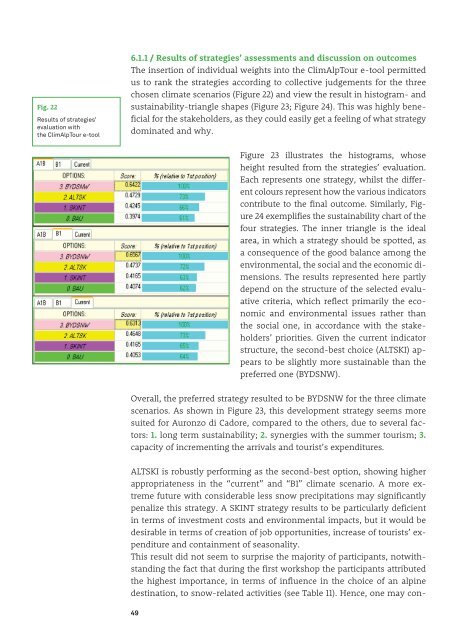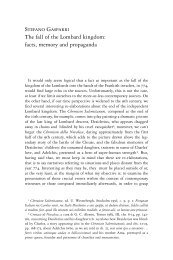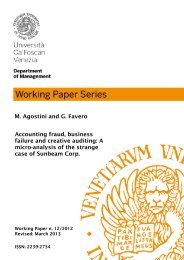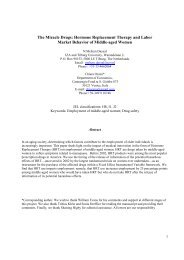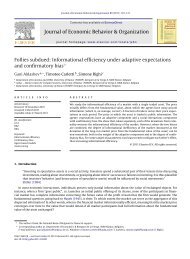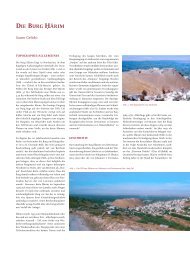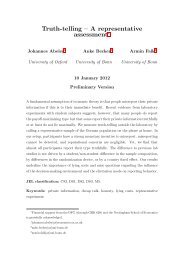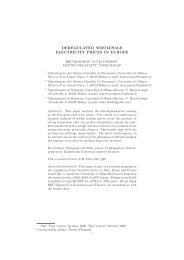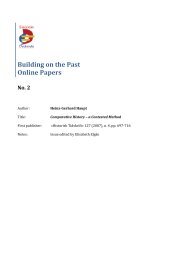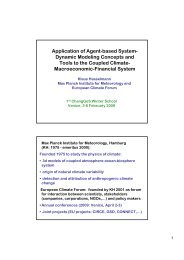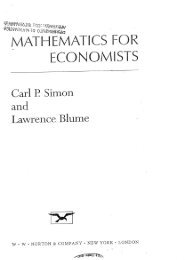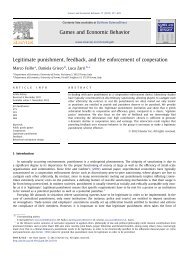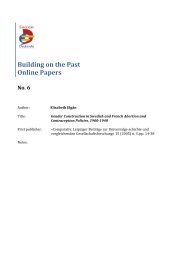The pilot area of Auronzo di Cadore (Belluno) - Università Ca
The pilot area of Auronzo di Cadore (Belluno) - Università Ca
The pilot area of Auronzo di Cadore (Belluno) - Università Ca
You also want an ePaper? Increase the reach of your titles
YUMPU automatically turns print PDFs into web optimized ePapers that Google loves.
Fig. 22<br />
Results <strong>of</strong> strategies’<br />
evaluation with<br />
the ClimAlpTour e-tool<br />
6.1.1 / Results <strong>of</strong> strategies’ assessments and <strong>di</strong>scussion on outcomes<br />
<strong>The</strong> insertion <strong>of</strong> in<strong>di</strong>vidual weights into the ClimAlpTour e-tool permitted<br />
us to rank the strategies accor<strong>di</strong>ng to collective judgements for the three<br />
chosen climate scenarios (Figure 22) and view the result in histogram- and<br />
sustainability-triangle shapes (Figure 23; Figure 24). This was highly beneficial<br />
for the stakeholders, as they could easily get a feeling <strong>of</strong> what strategy<br />
dominated and why.<br />
49<br />
Figure 23 illustrates the histograms, whose<br />
height resulted from the strategies’ evaluation.<br />
Each represents one strategy, whilst the <strong>di</strong>fferent<br />
colours represent how the various in<strong>di</strong>cators<br />
contribute to the final outcome. Similarly, Figure<br />
24 exemplifies the sustainability chart <strong>of</strong> the<br />
four strategies. <strong>The</strong> inner triangle is the ideal<br />
<strong>area</strong>, in which a strategy should be spotted, as<br />
a consequence <strong>of</strong> the good balance among the<br />
environmental, the social and the economic <strong>di</strong>mensions.<br />
<strong>The</strong> results represented here partly<br />
depend on the structure <strong>of</strong> the selected evaluative<br />
criteria, which reflect primarily the economic<br />
and environmental issues rather than<br />
the social one, in accordance with the stakeholders’<br />
priorities. Given the current in<strong>di</strong>cator<br />
structure, the second-best choice (ALTSKI) appears<br />
to be slightly more sustainable than the<br />
preferred one (BYDSNW).<br />
Overall, the preferred strategy resulted to be BYDSNW for the three climate<br />
scenarios. As shown in Figure 23, this development strategy seems more<br />
suited for <strong>Auronzo</strong> <strong>di</strong> <strong><strong>Ca</strong>dore</strong>, compared to the others, due to several factors:<br />
1. long term sustainability; 2. synergies with the summer tourism; 3.<br />
capacity <strong>of</strong> incrementing the arrivals and tourist’s expen<strong>di</strong>tures.<br />
ALTSKI is robustly performing as the second-best option, showing higher<br />
appropriateness in the “current” and “B1” climate scenario. A more extreme<br />
future with considerable less snow precipitations may significantly<br />
penalize this strategy. A SKINT strategy results to be particularly deficient<br />
in terms <strong>of</strong> investment costs and environmental impacts, but it would be<br />
desirable in terms <strong>of</strong> creation <strong>of</strong> job opportunities, increase <strong>of</strong> tourists’ expen<strong>di</strong>ture<br />
and containment <strong>of</strong> seasonality.<br />
This result <strong>di</strong>d not seem to surprise the majority <strong>of</strong> participants, notwithstan<strong>di</strong>ng<br />
the fact that during the first workshop the participants attributed<br />
the highest importance, in terms <strong>of</strong> influence in the choice <strong>of</strong> an alpine<br />
destination, to snow-related activities (see Table 11). Hence, one may con-


